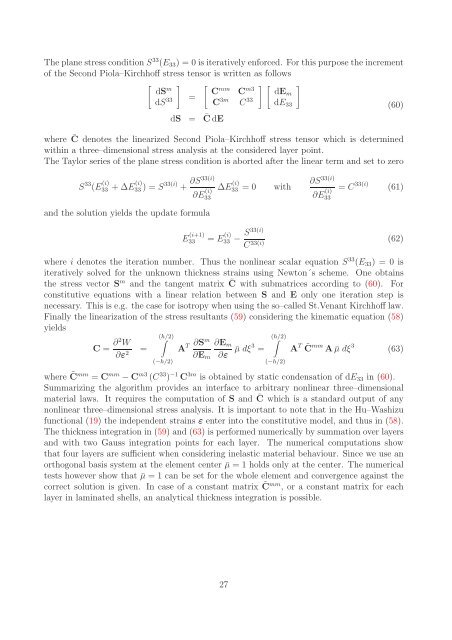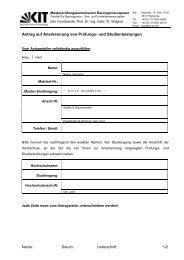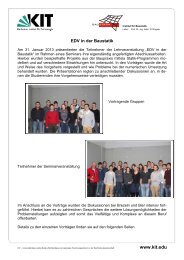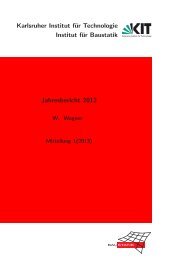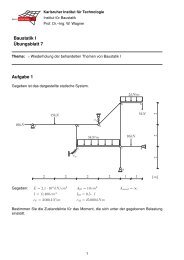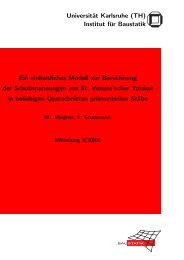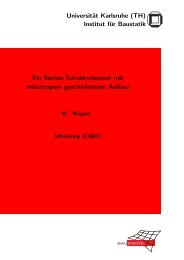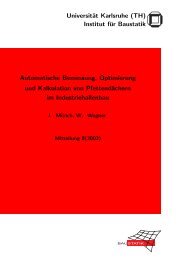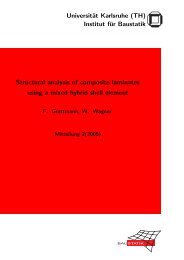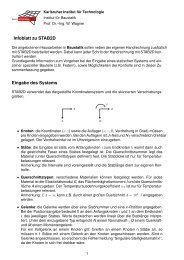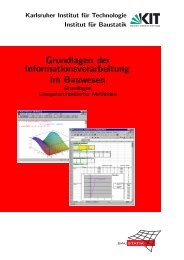Universität Karlsruhe (TH) - am Institut für Baustatik
Universität Karlsruhe (TH) - am Institut für Baustatik
Universität Karlsruhe (TH) - am Institut für Baustatik
Create successful ePaper yourself
Turn your PDF publications into a flip-book with our unique Google optimized e-Paper software.
The plane stress condition S 33 (E 33 ) = 0 is iteratively enforced. For this purpose the increment<br />
of the Second Piola–Kirchhoff stress tensor is written as follows<br />
[ ] [<br />
dS<br />
m C<br />
dS 33 =<br />
mm C m3 ][ ]<br />
dEm<br />
C 3m C 33 dE 33 (60)<br />
dS = ¯C dE<br />
where ¯C denotes the linearized Second Piola–Kirchhoff stress tensor which is determined<br />
within a three–dimensional stress analysis at the considered layer point.<br />
The Taylor series of the plane stress condition is aborted after the linear term and set to zero<br />
S 33 (E (i)<br />
33 +ΔE (i)<br />
33 )=S 33(i) + ∂S33(i)<br />
ΔE (i)<br />
∂E (i) 33 =0 with<br />
33<br />
and the solution yields the update formula<br />
∂S 33(i)<br />
∂E (i)<br />
33<br />
= C 33(i) (61)<br />
E (i+1)<br />
33 = E (i)<br />
33 − S33(i)<br />
C 33(i) (62)<br />
where i denotes the iteration number. Thus the nonlinear scalar equation S 33 (E 33 )=0is<br />
iteratively solved for the unknown thickness strains using Newton´s scheme. One obtains<br />
the stress vector S m and the tangent matrix ¯C with submatrices according to (60). For<br />
constitutive equations with a linear relation between S and E only one iteration step is<br />
necessary. This is e.g. the case for isotropy when using the so–called St.Venant Kirchhoff law.<br />
Finally the linearization of the stress resultants (59) considering the kinematic equation (58)<br />
yields<br />
C = ∂2 W<br />
∂ε 2 =<br />
(h/2) ∫<br />
(−h/2)<br />
A T ∂Sm<br />
∂E m<br />
∂E m<br />
∂ε ¯μ dξ3 =<br />
(h/2) ∫<br />
(−h/2)<br />
A T ˜Cmm A ¯μ dξ 3 (63)<br />
where ˜C mm = C mm − C m3 (C 33 ) −1 C 3m is obtained by static condensation of dE 33 in (60).<br />
Summarizing the algorithm provides an interface to arbitrary nonlinear three–dimensional<br />
material laws. It requires the computation of S and ¯C which is a standard output of any<br />
nonlinear three–dimensional stress analysis. It is important to note that in the Hu–Washizu<br />
functional (19) the independent strains ε enter into the constitutive model, and thus in (58).<br />
The thickness integration in (59) and(63) is performed numerically by summation over layers<br />
and with two Gauss integration points for each layer. The numerical computations show<br />
that four layers are sufficient when considering inelastic material behaviour. Since we use an<br />
orthogonal basis system at the element center ¯μ = 1 holds only at the center. The numerical<br />
tests however show that ¯μ = 1 can be set for the whole element and convergence against the<br />
correct solution is given. In case of a constant matrix ˜C mm , or a constant matrix for each<br />
layer in l<strong>am</strong>inated shells, an analytical thickness integration is possible.<br />
27


